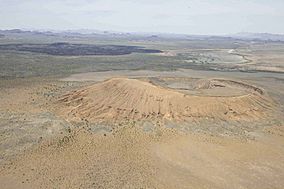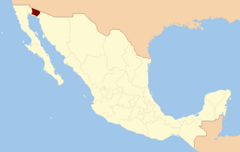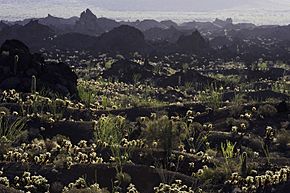El Pinacate y Gran Desierto de Altar Biosphere Reserve facts for kids
Quick facts for kids Reserva de la Biosfera El Piñacatey Gran Desierto de Altar |
|
|---|---|
|
IUCN Category Ia (Strict Nature Reserve)
|
|

Aerial view of El Pinacate y Gran Desierto de Altar Biosphere Reserve and adjacent volcano with black lava flows
|
|

Location of the Reserve in Mexico
|
|
| Location | Sonora, Mexico |
| Nearest city | Puerto Peñasco Plutarco Elías Calles San Luis Río Colorado |
| Area | 2,695.05 km2 (1,040.56 sq mi) |
| Established | June 10, 1993 |
| Governing body | Instituto Nacional de Ecología and Tohono O'odham |
| Official name: El Pinacate and Gran Desierto de Altar Biosphere Reserve | |
| Type: | Natural |
| Criteria: | vii, viii, x |
| Designated: | 2013 (37th session) |
| Reference #: | 1410 |
| State Party: | Mexico |
| Official name: Agua Dulce | |
| Designated: | 2 February 2008 |
| Reference #: | 1813 |
The El Pinacate y Gran Desierto de Altar Biosphere Reserve (which means "El Pinacate and Great Altar Desert Biosphere Reserve" in Spanish) is a special protected area in Mexico. It is also a World Heritage Site recognized by UNESCO. This amazing place is managed by the Mexican government, working with the state of Sonora and the Tohono Oʼodham people.
This reserve is located in the Sonoran Desert in northwest Mexico. It is east of the Gulf of California and just south of the border with Arizona, United States. It is one of the largest and most visible landforms in North America when seen from space. The main part of the landscape is a volcanic system called Santa Clara. It includes three important peaks: Pinacate, Carnegie, and Medio.
This area is home to many different kinds of life. You can find over 540 types of plants here. There are also 40 kinds of mammals, 200 types of birds, and 40 kinds of reptiles. Even amphibians and freshwater fishes live here. Some special animals that are in danger of disappearing live here. These include the Sonoran pronghorn, bighorn sheep, Gila monster, and Desert tortoise.
The biosphere reserve covers about 2,695 square kilometers (1,040 square miles). This is about half the size of the larger World Heritage Site, which is 7,146 square kilometers (2,759 square miles). This huge area is bigger than some Mexican states!
Contents
How the Pinacate Desert Was Formed
The El Pinacate y Gran Desierto de Altar Biosphere Reserve is famous for its unique features. It has a large volcanic shield and huge areas of active dunes. It also has the most Maar craters in the world. These are special craters formed by explosions when hot magma meets groundwater.
Volcanic Mountains and Craters
The Pinacate Peaks are a group of volcanic mountains and cinder cones. They are located in the northern part of the Reserve. The tallest peak is Cerro del Pinacate, also known as Santa Clara volcano. It stands about 1,190 meters (3,904 feet) tall. The name "Pinacate" comes from an old language called Nahuatl. It means "pinacatl," which is a type of stink beetle found in the Sonoran Desert.
The volcanoes in the Pinacate Peaks have erupted many times over about 4 million years. The last time they were active was about 11,000 years ago. The volcanic eruptions created amazing landscapes. They formed solid lava rocks, sand, and volcanic ash. This created beautiful colors and unique craters. Some of the most well-known craters are El Elegante, Cerro Colorado, MacDougal, and Sykes.
Training for Space
Did you know that NASA astronauts trained here? From 1965 to 1970, they came to the Gran Desierto de Altar. They practiced walking on the moon because the desert terrain is very similar to the lunar surface.
History of the Pinacate Region
The Pinacate y Gran Desierto de Altar area has a long and interesting history. People have lived here for thousands of years.
Early Inhabitants
The first people to live here were called the San Dieguito people. They were hunter-gatherers, meaning they found their food from nature. They moved between the mountains and the Gulf of California to find food. Their first time living here ended about 20,000 years ago. A very dry period, like an ice age, made them leave the mountains.
Later, the San Dieguito people returned during a cooler, wetter time. They lived much like their ancestors did. Natural water pools called Tinajas were very important for them. This second period ended about 9,000 years ago. Another dry period forced them to leave the area again.
The most recent native people in the Pinacate and Gran Desierto de Altar are the Pinacateño band. They are part of the Hia C-eḍ Oʼodham group. Like the earlier people, the Pinacateños traveled across the Pinacate area all the way to the sea. They searched for food and set up camps near the tinajas. They left behind signs of their lives, like networks of paths between water sources. You can also find old stone tools and pieces of pottery near these water spots.
Explorers and Scientists
Not many early explorers wrote about this area. It is thought that the first European to see the Pinacate mountains was Melchior Díaz in 1540. Later, in 1698, a priest named Eusebio Kino visited the site. He returned many times and even climbed to the top of El Pinacate. He named it Santa Clara Hill.
Before 1956, only a few scientists and explorers had visited El Pinacate y Gran Desierto de Altar. One famous group included MacDougal, Hornaday, and Sykes. They explored the western part of the mountains in 1907.
See also
 In Spanish: Reserva de la biosfera El Pinacate y Gran Desierto de Altar para niños
In Spanish: Reserva de la biosfera El Pinacate y Gran Desierto de Altar para niños




